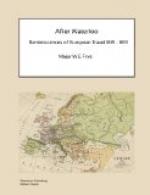There stood on the same spot a wooden statue of Christ
in the XVI century. One day an opulent Jew, on
passing by, made some scoffing or contemptuous remark
on it. He was overheard by some of the people,
accused of blasphemy and condemned to die; but on expressing
great contrition and offering to pay a fine to any
amount, he was pardoned, on the condition of his promising
to erect a bronze statue gilt of Jesus Christ on the
same spot, at his own expense, with an inscription
explaining the reason of its construction; which promise
he punctually performed. Prague abounds in Jews.
Two-thirds at least of its population are of that
persuasion. In the lower town the most striking
edifices are the palace of the Wallenstein family,
descendants of the famous Wallenstein, so distinguished
in the Thirty Years war. Annexed to this Palace
is a spacious garden, which is open to the public
as a promenade. It is well laid out. There
is a large aviary. This Palace covers a vast extent
of ground. The Colloredo family, who are descended
from Wenceslaus, have a superb Palace in this city;
and there is a stable belonging to it, partly in marble
and of rich architecture, capable of containing thirty-six
horses. No traveller who comes to Prague should
omit visiting these two Palaces of Wallenstein and
Colloredo. On the bridge over the Mulda before
mentioned, is the statue in bronze of St John Nepomucene,
on the spot from whence he was thrown into the river
by his brother saint, King Wenceslaus, for refusing
to divulge the gallantries of his (Wenceslaus’)
wife, to whom he was confessor. A favorite promenade
on Sundays is on the
Faerber Insel or Dyers
island, which is a small island on the Mulda.
Here the young men of the town come to dance with
the
grisettes and milliner girls of Prague,
who are renowned for their beauty and complaisance.
The Jewish burying ground is a curiosity for a person
who has never visited the Oriental countries.
The tombstones are stowed thick together. Everybody
recollects the anecdote of the ingenious method adopted
by Joseph II for squeezing a large sum of money from
the Jews of Prague, by giving out that he intended
to claim this cemetery, in order to build therein a
Palace. The Jews who, like all the Orientals,
have the most profound veneration for the spot where
their ancestors are buried, presented a large sum of
money to the Emperor, to induce him to renounce his
design.
The Stadt-Haus (Hotel de Ville) is a fine building;
and the Marktplatz (market square) is very
spacious, and contributes much to the beauty of the
town. In the centre of it stands an ancient fountain
of a dodecagonal form. The basin is of red marble,
and near it stands a large stone column, with a statue
of the Virgin, bronze gilt, on its summit. A well
supplied market, or rather fair, is carried on here
every day in the week. The Theatre is a fine
building and is of immense size. I witnessd the
representation of a burlesque tragedy called Die




